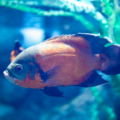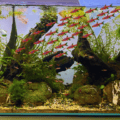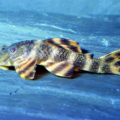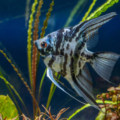The Zebra Angelfish is a showstopper and a beautiful addition to any freshwater tank. With its long majestic fins and elegant swimming behavior, it’s hard not to fall in love with this species, so it’s no surprise you’re here.

Discovering the Zebra Angelfish
If you’re an experienced aquarist, you probably already know there are two kinds of angelfish. So, for clarity, the Zebra species is part of the freshwater angelfish family.
These popular aquarium fish originate from South America’s Amazon River and Orinoco Basins but have now become staples worldwide in ornamental aquariums.
Without wasting your time, let me show you how you can breed this striped aquarium fish and maintain a successful tank.
History and Natural Habitat
Although the Zebra Angelfish’s origin is rooted in the beautiful waters of the Amazon basins of South America, through selective breeding, it’s found its way into North America and the rest of the world.
In the wild, the Amazon Basin fish are territorial explorers who search every nook and cranny of their environment. Their behavior and environment translate into their care requirements and how to set up their aquarium.
Despite taking them out of their tropical fish environment, hobbyists did their best to maintain their natural habitat by replicating its features in their tanks and ponds. Now, you’ll learn how to honor this freshwater river species’ roots and build a thriving Zebra Angelfish aquarium.
Physical Characteristics

Before we get to the tank requirements, you must understand the Zebra Angelfish’s appearance.
Like all angelfish, it has a triangular lateral body, but its defining feature is its beautiful black-and-white striped pattern, which is like that of an African zebra. Another uniqueness of these striped fish patterns is their randomness, such that each Zebra Angelfish has a distinct look.
The zebra angelfish fin structure, which is long, flowing, and edged, fanning out beautifully as it swims, is another reason this species is so captivating. Its dorsal and anal fins extend into elegant sweeping points, enhancing its swimming motion and contributing to its overall beauty.
The combination of these physical characteristics makes the Zebra Angelfish agile yet elegant swimmers and delicate pets.
Care Requirements for Zebra Angelfish
To provide the best Zebra Angelfish care, you must maintain optimal water conditions by keeping ideal tank parameters, having the right decoration and accessories, and practicing proper feeding habits.
Routine angelfish tank maintenance helps you note changes in the water parameters and gives you enough time to stabilize them. Regularly assess the water quality with a liquid test kit and create a feeding plan suited to overall freshwater fish care.
These cichlids thrive in warm, slightly acidic to neutral water, which resembles their natural environment, so here’s how to set up the ideal tank requirements.
Ideal Tank Setup for Zebra Angelfish

Their natural habitat is a collection of textures and colors with soft light and plenty of hiding spots. So, here are the important details you need to replicate the Amazon River basin in your Zebra Angelfish tank setup.
Tank Size
It would be best to have a tank large enough to accommodate their growth and tall enough not to hurt the fins. Remember that this species needs space to swim around and exhibit its curious nature.
A fully grown Zebra Angelfish is up to 6 to 8 inches in length and 4 inches in diameter, so the ideal tank size will hold at least 30 gallons of water.
If you own a community tank with other species, you must get a larger tank that holds up to 75 gallons of water, depending on the number of pets in the aquarium.
Decor
The closest way to replicate a natural habitat is to use your aquatic decor to mimic elements. The Amazon is full of plants, so adding soft, tall leaves—either artificial or real — is a nice touch to your aquarium.
Please don’t leave it bare with plants only. Also, add driftwood, granites, smooth rocks, and sand.
Lightning and Heating
When sketching your aquarium design, make room for lighting and heating. Provide at least 8 hours of light daily for the plants if they’re live plants, and set their timing to mimic a day and night cycle to stabilize your fish’s routine.
Typically, angelfish thrive in warm water, so you need a heating system that maintains a temperature of 76 to 82°F.
These ideal tank conditions will give your Zebra Angelfish quality of life. Ensure there are no sudden fluctuations, as that can lead to shock or stress that’ll affect your pet’s health. Before we get deep into health conditions, let’s look at dieting and feeding.
Feeding and Diet

Pellets

Larvae
Angelfish survive mainly on live food in the wild, like larvae, insects, crustaceans, and small fish, but they also feed on the plants in their surroundings. You can place them in the class of top and middle feeders depending on their environment and tank mates.
When caring for this variant in captivity, you must ensure they get a blend of foods found in their natural habitat. The Zebra Angelfish diet should contain high amounts of protein and fiber to help with their physical growth and mental stability.
The good part is that Angelfish are not picky eaters and will eat anything provided to them. They can eat common commercial fish foods like flakes and pellets but also enjoy live foods like bloodworms, brine shrimp, krill flakes, and tubifex worms.
When buying commercially processed food, choose only affordable and nutritious fish food required for improving your Angelfish’s strength and enhancing fish coloration. But your work doesn’t end here.
It’s important to monitor their feeding habits by creating a schedule that works for you and your pet. Ensure your pet eats at least twice daily but no more than three times, and space the timing between feeding hours to avoid overfeeding.
Overfeeding causes obesity, and excess food leads to waste and eventual water contamination. So, how can you tackle these health issues and common diseases?
Health and Common Diseases
Like most fish, Zebra angelfish’s health is prone to diseases caused by environment or food. Your fish could host parasitic nematodes or get food poisoning.
You can either prevent this or get reactive and treat the problems as soon as they show up. However, prevention and reaction only work when you know what you’re doing, so let me help you care for your pet. Here’s a list of some common fish ailments.
- Parasitic Infection: Nematodes are roundworms formed in unclean tanks that latch onto your pets. Their eggs grow in dirty food that find their way into your angelfish gut and begin the infection process.
- Ich: This manifests as white spots on the fish’s body and fins. You may see them scratching their bodies against objects or producing rapid gill movement.
- Dropsy: This is a result of overfeeding and produces symptoms like a swollen abdomen, lethargy, and scales resembling pinecones.
- Velvet Disease: This is a common parasitic infection that gives your Zebra Angelfish a distinctive velvety or dusty appearance on the body and gills.
Treatment of Common Fish Ailments
You can treat many of these diseases with over-the-counter antibiotics and anti-parasitic medication. However, you must first identify the exact illness before knowing which medication works.
It’s always best to take your pets to a certified vet for diagnosis, but if you’re an experienced aquarist, then you can also treat them yourself. Skin diseases often need creams such as salve, but sometimes the problem is within, so the fish also needs oral medication.
Prevention of Common Fish Ailments
Incorporating fish disease prevention techniques and practicing aquatic healthcare into your tank maintenance routines is the best way to keep your Angelfish safe from illnesses.
Healthcare plans for your pet involve providing highly nutritious meals, maintaining water quality, and performing regular tank maintenance.
Are you ready to raise a young Zebra Angelfish? Let’s find out.
Breeding Zebra Angelfish
The first step to breeding Zebra Angelfish is selecting a healthy breeding pair. Unless you are a seasoned angelfish keeper, distinguishing the males from the females can be quite difficult.
The easiest method is to get a breeding couple when they are younger, raise them into adulthood, and leave them to pair off naturally.
This video has been very helpful in identifying the sex of angelfish, I highly recommend it:
If you have multiple breeding pairs, select the best-looking pair and move them to a separate tank to kick off the angelfish reproduction process. But if not, you can choose new adults and pair them in a breeding tank.
Angelfish breed fast and lay hundreds of eggs every one to two weeks. The first set of eggs often fails to develop because the parents eat them. Here are some fry-rearing tips you can adopt for successful breeding —
- Create vertical or flat surfaces for your Angelfish to lay their eggs.
- The eggs typically hatch in 2-3 days; it’s important to monitor the eggs and separate the parents as soon as they hatch.
- Once the fry becomes free swimming, you can feed them with tiny foods like baby shrimp.
Behavior and Compatibility

Suckermouth Catfish
Zebra angelfish’s behavior is a result of their natural origin, which is why I started this review with a brief history lesson. They’re territorial when breeding and active swimmers who love exploring and roaming their environment.
When it comes to their social behavior, they prefer to have company but aren’t always nice to everyone.
Generally, Zebra Angelfish are peaceful unless cramped up with too many fish. They typically form peaceful fish communities with a variety of fish species like other cichlids and certain catfish like the suckermouth catfish.
Figuring out this aquarium fish’s compatibility with other fish is easy because of their calm and social personalities. Avoid aggressive fish that may nip at their fins and smaller fish, as the cichlids can feed on them.
Conclusion
Zebra Angelfish are an excellent addition to your aquarium because they add a touch of color and character. I’ve provided this Zebra Angelfish care overview for both beginner and seasoned fish hobbyists to show that caring for this beautiful creature is not as difficult as it seems.
f you follow the fish-keeping tips in this care guide, you can be sure your angelfish journey will be easy and fulfilling. The best aquarium maintenance advice I can give you is to pay attention to the size of your tank by ensuring you have at least a 30-gallon tank with plenty of plants, hiding spots, and open swimming space.
Zebra angelfish appreciation involves recognizing their beauty, understanding their behaviors, and valuing their role within the aquatic ecosystem. By providing the right living environment and care, you can fully enjoy the rewards of keeping an angelfish.










